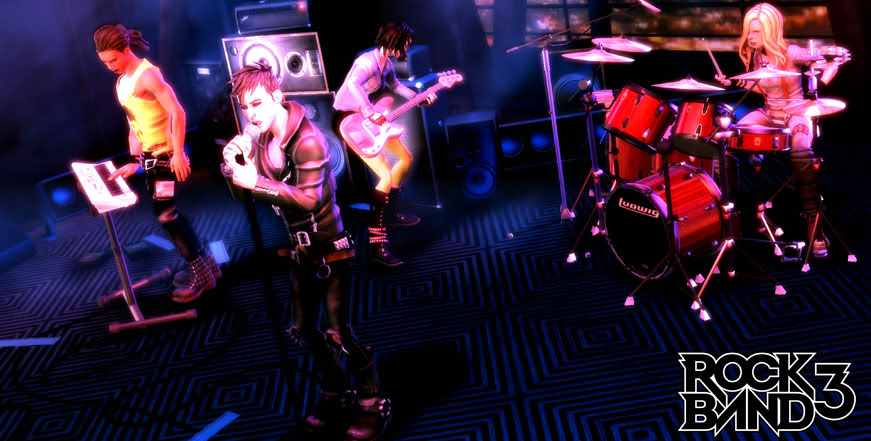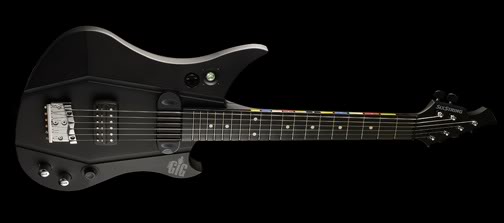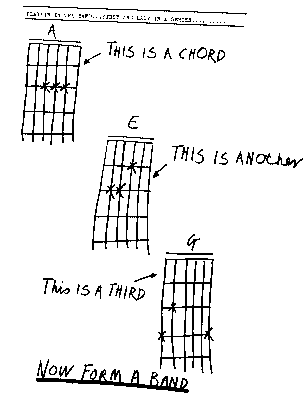This post has not been edited by the GamesBeat staff. Opinions by GamesBeat community writers do not necessarily reflect those of the staff.
The stench of body odor, beer, and blood fill the air. A cacophony of feedback jitters from an amplifier as musicians jack their guitars in. Someone from the crowd yells, "You suck!"
And suddenly, it hits: A wall of fucking sound. The audience members — as if possessed — run one another down as they slam their flesh together. Fist meets face. Face meets pavement.
Something about this atmosphere has always held my interest. Perhaps it's the intensity of the spectacle, or maybe I'm just a glutton for auditory punishment. Whatever the case, being on the floor is nothing compared to being on stage.

Rock Band 3 sports a "real guitar" controller, too; I didn't get a chance to test it out at E3.
And that's something that games like Guitar Hero and Rock Band attempt to bring into your living room — that adrenaline rush, which seems to only last a moment.
I've played music all my life, and it's featured centrally in my identity for as long as I can remember. But I've never really liked rhythm games — I just don't feel that the focus on showmanship and virtuosity is what music is all about.
So this E3, I set out to test a few real-guitar rhythm games to see if any could sway my opinion.
First up is Hero Maker, which uses a real guitar built by Peavey. I plugged into the provided amplifier; the instrument sounds a lot like a cheap Fender Stratocaster, but that's nothing a good stompbox and an all tube half-stack can't fix.
The demo guy set me up with Guitar Hero: World Tour. I pick the Sex Pistols's "Pretty Vacant." But the song sounds little like I remember from the 1977 album Never Mind the Bollocks, Here's the Sex Pistols, which — appropriately enough — sets the tone for my time with the instrument.

This isn't Peavey's Hero Maker guitar, but it looks awfully similar.
The peripheral works with a sensor bar placed under the strings. For now, it's only under the high "e," so I have to play there (the developer plans to release a guitar with a sensor that covers the entire neck, but that isn't available yet). Peavey has also helpfully labeled the frets with the standard Guitar Hero/Rock Band note colors.
Playing an entire song on the high "e" string gets annoying fast. I don't really feel like I'm playing guitar, either. This is reinforced by the fact that I must engage a built-in mute bar (which muffles all the strings); otherwise, the game is unable to detect my inputs. Playing the guitar feels stilted.
I'm not impressed.
Next, I happen upon the You Rock Guitar. It's a device of a different beast — the instrument is entirely digital. It has these string-like sensors that run up and down the neck of the guitar, so you'll never need to tune it. Over the body is a separate set of tightly held plastic strings for stumming, which barely make any sound at all.
But don't be fooled — this guitar can also plug into an amplifier. It comes loaded with an array of preset sounds and tunings. I tried out many of them, but nothing sounded interesting at all. I'll take my DeuceTone Rat over these any day.

No strings means your fingers won't hurt from playing. So, what's the point?
But because the guitar doesn't really have strings, it felt strange while playing. Hammer-ons and pull-offs sounded bad, and chords fared no better. It sounded like those crappy, digital floor pedals preloaded with over 100 blowhard sounds that you'd never want to use in a real band.
Just as with the Peavey instrument, the You Rock Guitar also comes labeled with the standard-rhythm-game colors. You can press any "string" on the fret to play — just as you would with the colored buttons on the phony guitars. In all honesty, it doesn't really feel any different.
Finally, I try out Power Gig: Rise of the SixString, which is a full-featured rhythm game from Seven 45 Studios. In addition to developing this title, they've built their own real guitar peripheral that players can also plug into an amplifier. Unlike the others, this instrument had actual weight to it, which made the guitar feel much more like the real thing.

Seven 45 Studios's custom guitar.
This is further evidenced by the fact that Seven 45 studios has designed their own rhythm game with a real-guitar controller in mind. The note cues (which again follow the established color standard) will tell the player when to perform hammer-on and pull-off techniques, which adds to the feel of actually playing the instrument.
But more importantly, Rise of the SixString sports a "chord mode," which tells players when and where to play power chords during a song. Although this is definitely a step in the right direction, the guitar requires that a mute bar prevents the strings from vibrating — just as with Hero Maker.
In the end, though, none of these excite me. The real problem lies with the games that these instruments are designed for. Guitar Hero's and Rock Band's distillation of a song into five, color-coded notes that sit next to one another on the fretboard is not a true simulation of playing guitar. Each of these peripherals falls into that trap.
Furthermore, that I need to mute the strings (or that no strings exist at all) removes the feel of playing the real instrument. Calloused fingers are a part of the experience, and I wouldn't wish them away. Playing guitar is intimately physical, but these imitations always seem one step removed.
Making music is about creating something that's your own — something unique, personal, and creative. Mimicking the ideas of aging, arena rock stars isn't that. In the immortal words of punk rock:

